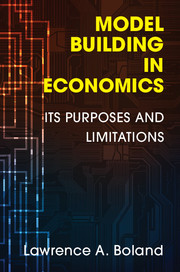Book contents
- Frontmatter
- Dedication
- Contents
- Preface
- Acknowledgements
- Prologue: Model building yesterday versus today
- Part I Theoretical Models
- Part II Empirical Models
- 5 Microeconomic versus macroeconomic empirical model building
- 6 On building macro-econometric models
- 7 Modeling and forecasting
- Part III Testing and Models
- Part IV Methodological Considerations
- Bibliography
- Name index
- Subject index
7 - Modeling and forecasting
Published online by Cambridge University Press: 05 October 2014
- Frontmatter
- Dedication
- Contents
- Preface
- Acknowledgements
- Prologue: Model building yesterday versus today
- Part I Theoretical Models
- Part II Empirical Models
- 5 Microeconomic versus macroeconomic empirical model building
- 6 On building macro-econometric models
- 7 Modeling and forecasting
- Part III Testing and Models
- Part IV Methodological Considerations
- Bibliography
- Name index
- Subject index
Summary
We should not indulge in high hopes of producing rapidly results of immediate use to economic policy or business practice. Our aims are first and last scientific. … The only way to a position in which our science might give positive advice on a large scale to politicians and business men, leads through quantitative work. For as long as we are unable to put our arguments into figures, the voice of our science, although occasionally it may help to dispel gross errors, will never be heard by practical men.
Joseph Schumpeter [1933, p. 12]The … fundamental point is that it will be necessary to distinguish between ‘forecasting’ and ‘prediction’. Forecasting will be limited to the extrapolations based on empirical models or data exploration, whereas a prediction will be formed from a theoretical model.
Clive Granger [2012, p. 312]It’s tough to make predictions, especially about the future.
Yogi BerraEconomists have been building econometric models for several decades. Econometric models by design attempt to capture or represent simultaneously the data of interest and the ideas about how the modeled economy functions as reflected in that data. The primary task is one of identifying a set of parameters or constants that can be seen to characterize the economy being modeled. Such models are thought to represent a cause and effect relationship between two types of observable quantities. The effects are the endogenous variables being explained and the causes are the exogenous variables whose values are determined either by nature or by public policy autonomously but not necessarily independently of the model. Truly exogenous variables are variables determined by events beyond anyone’s control or by prior artificial constructs that by design are completely within the control of governmental policy makers (e.g., tax rates, subsidies, etc.). It is the posited fixed parameters that ultimately determine the effects of any changes in the causes. The hope has always been that econometric model builders could succeed in developing a model that would simulate accurately the workings of the economy, and with such a model, if the values of all its fixed parameters could be measured, we would then have an excellent and reliable tool for forming predictions and forecasts of the future state of the economy or of the effects of changes in government policies.
- Type
- Chapter
- Information
- Model Building in EconomicsIts Purposes and Limitations, pp. 123 - 146Publisher: Cambridge University PressPrint publication year: 2014



